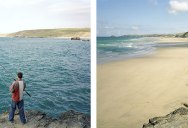Identical Portraits Along the British Coast at High and Low Tide
Since 2003 Michael Marten has travelled to different parts of the British coast to photograph identical views at high and low tide, six or eighteen hours apart. His beautiful and surprising photographs reveal how the twice daily rhythm of ebb and flood can dramatically transform the landscape.
From holiday beaches to industrial estuaries, the photographs record two moments in time, two states of nature. In Sea Change: A Tidal Journey Around Britain, Marten presents 53 of these diptychs, with an introduction by leading English nature writer Robert Macfarlane.
One aspect of what makes these photographs so compelling is the fascination of comparing each pair of pictures, spotting what has or hasn’t changed. The contrasting views play with our sense of depth and perspective, and show how subjective is our perception of landscape.
The Sifter recently caught up with Marten via email for an insightful interview about the project and the state of photography today. For more from Marten, check out the links below.
Website | Prints | Buy the Book
Worms Head, Glamorgan. 25 June 2005
High water 9:45 am, low water 4 pm

Website | Prints | Buy the Book
Perranporth, Cornwall. 29 and 30 August 2007
Low water 12 noon, high water 8 pm

Website | Prints | Buy the Book
Perranporth, Cornwall. 28 and 29 August 2007
High water 6 pm, low water 11:20 am

Website | Prints | Buy the Book
What is it about coastal landscapes that seems to influence much of your work?
I am interested in trying to show change in nature – change due to natural processes rather than human actions. The twice daily change of the tides, the erosion of cliffs, the rearrangement of beaches and dunes are examples of this. Then there’s the visual wonder of the sea, its ever-changing moods and colours, its drama and serenity. A great deal of current landscape photography is about humans more than it’s about the land: photographs of quarries, pollution, where battles were fought, where crimes were committed, where farmers work; the exploitation and despoliation of the environment, the ways people relate to it. I’m keener to explore the dynamics and forms of land and sea in themselves, whether people or buildings appear in a view or not.
St Michael’s Mount, Cornwall. 25 and 26 June 2009
Low water 1:15 pm, high water 8 am

Website | Prints | Buy the Book
St Cwyfan’s ‘church-in-the-sea’, Isle of Anglesey. 9 April 2012
High water 12 noon, low water 5:45 pm

Website | Prints | Buy the Book
You captured ‘Sea Change’ for nearly a decade. Can you share one of the more memorable or challenging locations to shoot?
My favourite tidal pair are these pictures [below] of a salmon fishery in the Solway Firth in south-west Scotland. Nets are hung on the poles to catch the fish when they run in from the Atlantic, returning to their native rivers. When I found this place, at low tide on a still grey luminous afternoon, I clambered halfway up a 50-foot cliff to find this viewpoint on a wide ledge.
When I returned the next morning as the tide was flooding in, I climbed down to the ledge from the clifftop. A real gale was howling and I feared that even with a solid tripod there would be too much camera shake for my 5×4-inch view camera (a wood and brass affair over which I placed a black cloth to see the image upside down on the camera’s ground-glass screen). Luckily, the ledge was perfectly sheltered from the wind by a jutting out rock. So I spent two wonderful hours there watching the huge waves come pounding in below. I even phoned my wife in London to tell her how exciting it was.
Salmon fishery, Solway Firth. 27 and 28 March 2006
Low water 5:20 pm, high water 12 noon

Website | Prints | Buy the Book
Flamborough, Yorkshire. 27 and 28 September 2007
High water 5 pm, low water 11:45 am

Website | Prints | Buy the Book
You’ve been involved with photography since the 1970’s – how has it changed in the digital age? Where do you see it going?
One effect of digital is that there is now no cost in making additional pictures. When I used my 5×4-inch view camera, every exposure would cost me about £7 (US$ 10) in film and processing. That served wonderfully to concentrate the mind. Did I really want to take this picture? Was this the best viewpoint, composition, moment I could choose? With digital, you can make dozens or hundreds of exposures and then spend ages at your computer deciding which is best. In this sense, digital photography can easily become thoughtless. I do miss that discipline of analog.
Holy Island causeway, Northumberland. 7 May 2012
Low water 10:30 am, 3:20 pm, high water 4:20 pm

Website | Prints | Buy the Book
Rock, Cornwall. 21 and 22 March 2011
Low water 11:30 am, high water 7:20 am

Website | Prints | Buy the Book
The colour in your photographs have such a natural and realistic feel which is refreshing in this day of over-processed and hyper-saturated imagery. Is this an important element of your work?
Yes, my aim is to create pictures that look as natural as possible. In northern countries such as Britain the light is often soft, dull, and subtle. That’s what I like. I avoid sunny days if possible. I like moody, grey skies: they help to bring out subtle colours in the land and the sea. Landscape photographs where the saturation has patently been increased artificially to achieve some supposedly romantic effect are, in my view, crude and amateur.
Severn Bridge, Monmouthshire. 8 and 9 March 2008
Low water 2:30pm, high water 8:20am

Website | Prints | Buy the Book
River Avon, Bristol. 11 February 2005
High water 10:20 am, low water 2.50 pm

Website | Prints | Buy the Book
What advice would you give to aspiring photographers?
Look once, look twice, look three times, then look away and look again. Take the time to just let the lines, light, colours, and textures of a scene fill your vision. This is advice I myself fail to follow ninety percent of the time! It is very very difficult to see with clean eyes, eyes that are innocent of preconceptions, free from what you’ve seen other people do before. To be true to your own vision – just to identify your own vision – is tough; to make original photographs even tougher.
Blackpool, Lancashire. 16 August 2010
Low water 11:20 am, high water 4 pm

Website | Prints | Buy the Book
Rhossili, Glamorgan. 24 June 2005
High water 8:30 am, low water 2:20 pm

Website | Prints | Buy the Book

Sign up to get our BEST stories of the week straight to your inbox.








